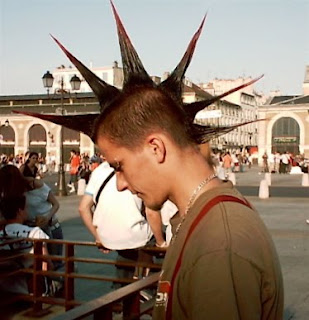I've been running into more and more heady French people who have visited or are planning a trip to Texas--not for love or money, but for pure-D, as in Dallas, tourism. They have to be prepared to rent a car and drive through Waring Blender-like traffic patterns, but the big horizon, fine contemporary architecture, citified cowboy culture, and mild climate beckon them to Dallas, the eighth largest city in the United States.
When my kicky Parisian architect friend returned from Big-D, he came back raving about the friendly and flashy city where the official slogan is "Live large. Think big." I'll say big; indelibly marked in my memory of the early 1990's Dallas landscape is the image of a huge American flag, about the size of ten king-sized bedsheets, gloriously draped from the top ledge of a tall building. Everything is big in Dallas, including its urban arts district, which today is the largest in the nation, or the Galleria Mall, the epitome of the upscale American shopping center, and tooted by USA Today as "one of the top ten places to spend it all." Its design was inspired by the famous Italian commercial mall, Galleria Vittorio Emanuele built in Milan in 1867, and seemed to be my French friend's favorite Dallas space.
The architectural landmark on the Dallas skyline that everyone wants to see from every angle is the photogenic Fountain Place Tower, built from 1983 thru 1986. (You might have already seen it on the Dallas television series, which by the way was a big hit with French television viewers, where it was portrayed as the Ewing Oil Building. ) It resembles a giant multi-faceted crystal, having a different profile from every direction, due to its unusual slanting sides. The 60-story skyscraper was designed by world-famous I.M. Pei, who is no stranger to downtown Dallas where he has realized other projects including the city hall and the symphony center. (Nor is he a stranger to Paris, where he designed the glass pyramid addition to the Louvre's courtyard.)
 Dynamic Dallas is also a part of the fourth largest metropolitan area in the United States, which includes Fort Worth, home of the Kimbell Art Museum--a fine example of architectural modernism and a reference for museum design. Constructed from 1967 thru 1972, the acclaimed building is the work of architect Louis Kahn. It's formed by a series of long parallel barrel vaults, each one open along the length of its crown where double curved skylights provide diffused natural light for optimal viewing of artwork. The museum which houses a small but select collection of European, Asian and Precolumbian works, also produces exceptional, world-class temporary exhibits.
Dynamic Dallas is also a part of the fourth largest metropolitan area in the United States, which includes Fort Worth, home of the Kimbell Art Museum--a fine example of architectural modernism and a reference for museum design. Constructed from 1967 thru 1972, the acclaimed building is the work of architect Louis Kahn. It's formed by a series of long parallel barrel vaults, each one open along the length of its crown where double curved skylights provide diffused natural light for optimal viewing of artwork. The museum which houses a small but select collection of European, Asian and Precolumbian works, also produces exceptional, world-class temporary exhibits.  From 1994-1997 the Kimbell unabashedly flaunted the pedigree of its chief curator during that time, Joachim Pissarro, great-grandson of the French impressionist painter, Camille Pissarro. Another interesting tidbit about the museum is that in 1981 it purchased a painting that strongly resembled a work of the great 17th century artist from Lorraine, Georges de La Tour. Because it was thought to be a copy, its price was much lower than an authentic Georges de La Tour would have been. The Kimbell bought the piece considering it to be a good deal for a beautiful work, regardless of who painted it. A wise decision, because later advanced identification methods proved it to be a real Texas-sized bargain and a true Georges de La Tour, Le Tricheur à l'As de Trèfle. (Cheater with the Ace of Clubs) A variant of the same painting, Le Tricheur à l'As de Carreau (Cheater with the Ace of Diamonds), is at the Louvre in Paris.
From 1994-1997 the Kimbell unabashedly flaunted the pedigree of its chief curator during that time, Joachim Pissarro, great-grandson of the French impressionist painter, Camille Pissarro. Another interesting tidbit about the museum is that in 1981 it purchased a painting that strongly resembled a work of the great 17th century artist from Lorraine, Georges de La Tour. Because it was thought to be a copy, its price was much lower than an authentic Georges de La Tour would have been. The Kimbell bought the piece considering it to be a good deal for a beautiful work, regardless of who painted it. A wise decision, because later advanced identification methods proved it to be a real Texas-sized bargain and a true Georges de La Tour, Le Tricheur à l'As de Trèfle. (Cheater with the Ace of Clubs) A variant of the same painting, Le Tricheur à l'As de Carreau (Cheater with the Ace of Diamonds), is at the Louvre in Paris.
Muy bonito! Find luscious in-season fresh fruit and vegetables neatly stacked all in a row at the Dallas Farmers Market, located downtown. Practically a drive-thru, it's a long hangar full of stands with parking in front of the vendor of your choice. (Don't forget, Dallas is extra roomy car country where distances separating two points can be far.) It's where the locals go and open 362 days a year. Extra sweet.
Photos
Text & photos ©2009 P.B.Lecron with the exception of photos of Kimbell Art Museum: ©2008 Kimbell Art Museum






































